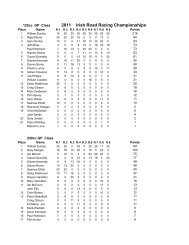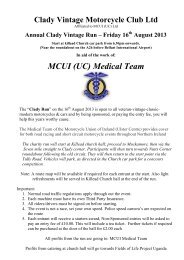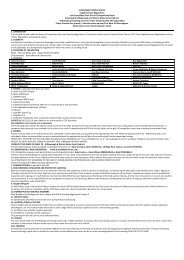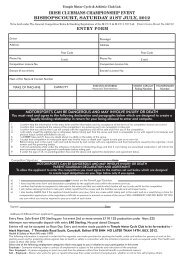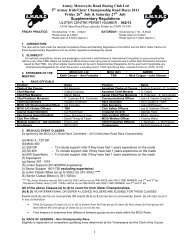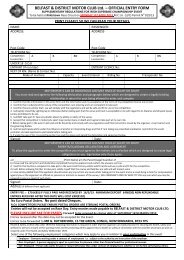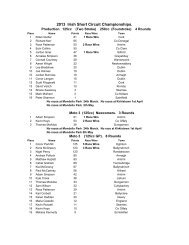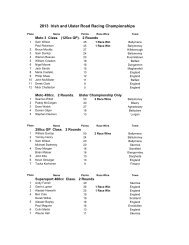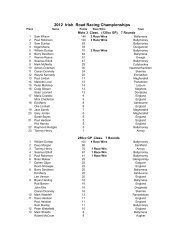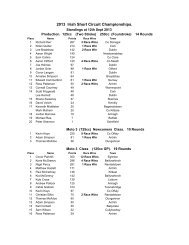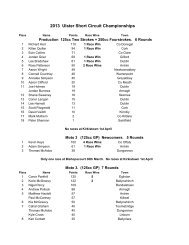2012 InternatIonal north West 200 Motor CyCle road raCe - MCUI(UC)
2012 InternatIonal north West 200 Motor CyCle road raCe - MCUI(UC)
2012 InternatIonal north West 200 Motor CyCle road raCe - MCUI(UC)
Create successful ePaper yourself
Turn your PDF publications into a flip-book with our unique Google optimized e-Paper software.
2.4.10.5 Wheels<br />
Wheels may be replaced (see Art. 2.3.4) and associated parts may be altered or replaced from those fitted to the<br />
homologated motorcycle. Carbon fibre or carbon composite wheels are not allowed, unless the manufacturer has equipped<br />
the homologated production model with this type of wheel.<br />
Bearings, seals, and axles may be altered or replaced from those fitted to the homologated motorcycle. The use of titanium<br />
and light alloys is forbidden for wheel spindles (axles).<br />
Wheel balance weights may be discarded, changed or added to.<br />
Any inner tube (if fitted) or inflation valves may be used.<br />
Wheel rim diameter size (front and rear) 16.5 inches<br />
Front wheel rim width : 3.50 inches.<br />
Rear wheel rim width : 6.25 in.<br />
Application from 1st January 2013<br />
Wheels must be made from aluminium alloys.<br />
2.4.10.6 Brakes<br />
Front brake master cylinder may be altered or replaced from those fitted to the homologated motorcycle.<br />
Front brake callipers may be altered or replaced from those fitted to the homologated motorcycle.<br />
Wheel rim diameter size (front and rear) 17 inches<br />
Front wheel rim width : 3.50 inches<br />
Rear wheel rim width : 6.00 inches<br />
Rear brake master cylinder may be altered or replaced from those fitted to the homologated motorcycle.<br />
Rear brake callipers may be altered or replaced from those fitted to the homologated motorcycle.<br />
Brake pads or shoes may be altered or replaced from those fitted to the homologated motorcycle.<br />
Brake hoses and brake couplings may be altered or replaced from those fitted to the homologated motorcycle. The split of<br />
the front brake lines for both front brake callipers must be made above the lower fork bridge (lower triple clamp).<br />
Brake discs may be altered or replaced from those fitted to the homologated motorcycle. Only ferrous materials are<br />
allowed for brake discs. The use of exotic alloy materials for brake callipers (i.e. aluminium-beryllium, etc.) is not allowed.<br />
The Anti Lock Brake System (ABS) may be used only if installed in the homologated model for <strong>road</strong> use. However, it must<br />
be completely standard (any mechanical or electronic part must remain as homologated, brake discs and master cylinder<br />
levers excluded), and only the software of the ABS may be modified.<br />
The Anti Lock Brake System (ABS) can be disconnected and its ECU can be dismantled. The ABS rotor wheel can be<br />
deleted, modified or replaced.<br />
2.4.10.7 Handlebars and hand controls<br />
Handlebars, hand controls and cables may be altered or replaced from those fitted to the homologated motorcycle.<br />
Engine stop switch must be located on the handle bars.<br />
2.4.10.8 Foot rest and foot controls<br />
Foot rest/foot controls may be relocated, but the original mounting points must be used.<br />
Foot rests may be rigidly mounted or a folding type which must incorporate a device to return them to the normal position.<br />
The end of the foot rest must have at least an 8mm solid spherical radius. (see diagram A & C).<br />
Non folding footrests must have an end (plug) which is permanently fixed, made of aluminium, plastic, Teflon or equivalent<br />
type of material (min. radius of 8mm). The plug surface must be designed to reach the widest possible area of the footrest.<br />
The FIM Superbike Technical Director has the right to refuse any plug not satisfying this safety purpose.<br />
2.4.10.9 Fuel tank<br />
The fuel tank must maintain the homologated appearance and location; however its actual shape can be slightly<br />
changed to suit the rider’s preference. The tank may be modified below the upper frame line and under the seat.<br />
The material of construction of the fuel tank may be altered from the one of the tank fitted to the homologated<br />
motorcycle.<br />
All fuel tanks must be filled with fire retardant material, or be fitted with a fuel cell bladder.<br />
Fuel tanks made of composite materials (carbon fibre, aramid fibre, glass fibre, etc.) must have passed the FIM Standards<br />
for fuel tanks or be lined with a fuel cell bladder.<br />
Tanks made of composite material must bear the label certifying conformity with FIM Fuel Tank Test Standards. Fuel tanks<br />
without a fuel cell bladder must bear a label certifying conformity with FIM Fuel Tank Test Standards.<br />
Such labels must include the fuel tank manufacturer’s name, date of tank manufacture, and name of testing laboratory.<br />
Each manufacturer is requested to inform the FIM/CCR Secretariat of its fuel tank model(s) which have passed the FIM test<br />
standards, together with a copy of the fuel tank label. Full details of the FIM Fuel Tank Test Standards and Procedures are<br />
available from the FIM (See ‘Fuel Tank Test Standards’ below).<br />
Fuel cell bladders must conform to or exceed the specification FIM/FCB-<strong>200</strong>5.<br />
Full details of this standard are available from the FIM.<br />
22



